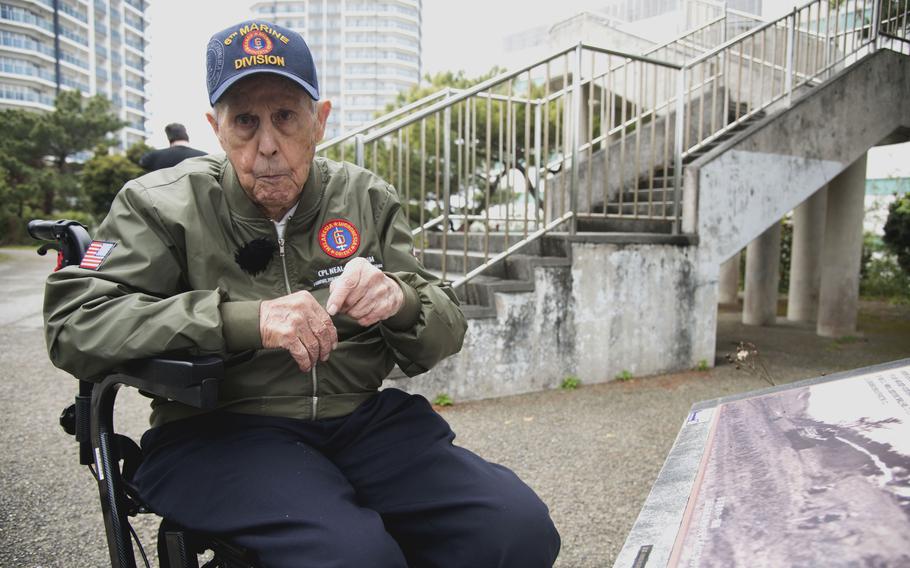
Neal McCallum, a Marine Corps veteran of the World War II Battle of Okinawa, speaks about his wartime experiences at Sugar Loaf Hill in Naha city, Okinawa, Japan, March 28, 2025. (Brian McElhiney/Stars and Stripes)
Walter LaSota was blown out of a foxhole by a Japanese bomb the first time he was wounded during the World War II Battle of Okinawa.
LaSota, a private with I Company, 22nd Marine Regiment, 6th Marine Division, and another Marine were in the foxhole at Sugar Loaf Hill in Naha city in early May 1945.
“He used to carry my extra ammunition and all, and the man was 33 years old — I used to call him ‘Pop,’ ” LaSota, 99, of Reading, Pa., said Monday during a visit to Toguchi Beach, a key landing site for the Marine Corps during the battle. “To this day I can’t remember his right name.”
LaSota remembered Pop shouting two words: “Dive!” and “Bomb!”
“When it blew, it blew me and I just rolled down over the hill,” he said. “I didn’t know I went down over the hill because I couldn’t hear, I couldn’t see, right? To this day I don’t know whatever happened to him; I don’t know whether he got killed by that bomb or not. But I was hoping that he didn’t have no suffering with the Japanese getting a hold of him.”
The Battle of Okinawa lasted from April 1 to June 22, 1945. Two-time Purple Heart recipient LaSota returned to the island for the first time in 80 years with help from the Eagle Society, which brings WWII veterans back to their battle sites.
More than 12,000 U.S. service members were killed and another 37,000 wounded during the campaign to capture the island, while about 90,000 Japanese troops were killed, according to the National World War II Museum.
About a third of the island’s civilian population died in the fighting, according to Cord Scott, who teaches history at the University of Maryland Global Campus on Okinawa. Estimates range from 100,000 to 188,000 Okinawan deaths, according to Scott and Marc Gallicchio, the Mary M. Birle chair in American History at Villanova University.
“This battle ends up being so devastating for so many sides that it influences the decision to drop the bomb, to be very blunt,” Scott said at Stars and Stripes’ Okinawa office Monday, referring to the atomic bombings at Hiroshima and Nagasaki on Aug. 6 and 9, 1945, respectively.
Neal McCallum was a private first class with Fox Company, 29th Marine Regiment, 6th Marine Division during the fight to take Sugar Loaf Hill. His regiment followed LaSota’s.
“The 22nd Marines were ahead of us, and they were shot through,” McCallum, 98, of Seffner, Fla., said at the war memorial on the hill Friday. He was visiting for the first time since 2000 with the Best Defense Foundation and its founder, former Kansas City Chiefs and San Diego Chargers linebacker Donnie Edwards.
The Marines relieved the U.S. Army’s 27th Infantry Division at Sugar Loaf, according to the WWII museum. The U.S. wanted the hill to continue pushing into Naha city, the island’s most populated urban area, according to Scott.
“At the same point, you’re close to Shuri where [Japan’s] 32nd Army is headquartered at,” Scott said. “So, the idea is that if you can get down here, you can swing around, cut them off and keep pushing.”
McCallum was there when Marines with Dog Company in his regiment took the hill on May 18. The next day, he was hit in his right calf by a shell fired from Shuri Castle.
“I’m being relieved by the 4th Marines, I’m leaving my foxhole, and I get about 150 steps,” when the “big guns” at Shuri opened and he was wounded, he said.
Earlier that day, his friend Sgt. Victor Hanson was killed by machine gun fire. Hanson was the uncle of military historian and political commentator Victor Davis Hanson.
“When we would go to the shower and so forth, he would always punch me on the shoulder,” McCallum said. “That’s how we became friends — but not close friends, because sergeants were a big deal.”
McCallum said he never stops thinking about Okinawa.
“I think of all my buddies that I left behind,” McCallum said. “I think about them every day. I think about this [battle] every day.”
McCallum pointed to his leg.
“I think about this every day,” he continued. “But I say this was a small price to pay to be alive.”